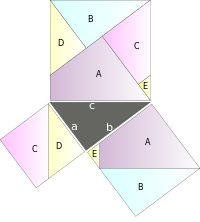
In mathematics and computer science, an algorithm is a finite sequence of rigorous instructions, typically used to solve a class of specific problems or to perform a computation. Algorithms are used as specifications for performing calculations and data processing. More advanced algorithms can use conditionals to divert the code execution through various routes and deduce valid inferences, achieving automation eventually. Using human characteristics as descriptors of machines in metaphorical ways was already practiced by Alan Turing with terms such as "memory", "search" and "stimulus".
The P versus NP problem is a major unsolved problem in theoretical computer science. Informally, it asks whether every problem whose solution can be quickly verified can also be quickly solved.
Complexity characterises the behaviour of a system or model whose components interact in multiple ways and follow local rules, leading to non-linearity, randomness, collective dynamics, hierarchy, and emergence.
In theoretical computer science and mathematics, computational complexity theory focuses on classifying computational problems according to their resource usage, and relating these classes to each other. A computational problem is a task solved by a computer. A computation problem is solvable by mechanical application of mathematical steps, such as an algorithm.

KISS, an acronym for "Keep it simple, stupid!", is a design principle first noted by the U.S. Navy in 1960. First seen partly in American English by at least 1938, the KISS principle states that most systems work best if they are kept simple rather than made complicated; therefore, simplicity should be a key goal in design, and unnecessary complexity should be avoided. The phrase has been associated with aircraft engineer Kelly Johnson. The term "KISS principle" was in popular use by 1970. Variations on the phrase include "keep it super simple", "keep it simple, silly", "keep it short and simple", "keep it short and sweet", "keep it simple and straightforward", "keep it small and simple", "keep it simple, soldier", "keep it simple, sailor", "keep it simple, sweetie", "keep it stupidly simple", or "keep it sweet and simple".

In theoretical computer science and mathematics, the theory of computation is the branch that deals with what problems can be solved on a model of computation, using an algorithm, how efficiently they can be solved or to what degree. The field is divided into three major branches: automata theory and formal languages, computability theory, and computational complexity theory, which are linked by the question: "What are the fundamental capabilities and limitations of computers?".
In philosophy, Occam's razor is the problem-solving principle that recommends searching for explanations constructed with the smallest possible set of elements. It is also known as the principle of parsimony or the law of parsimony. Attributed to William of Ockham, a 14th-century English philosopher and theologian, it is frequently cited as Entia non sunt multiplicanda praeter necessitatem, which translates as "Entities must not be multiplied beyond necessity", although Occam never used these exact words. Popularly, the principle is sometimes paraphrased as "The simplest explanation is usually the best one."
A puzzle is a game, problem, or toy that tests a person's ingenuity or knowledge. In a puzzle, the solver is expected to put pieces together in a logical way, in order to arrive at the correct or fun solution of the puzzle. There are different genres of puzzles, such as crossword puzzles, word-search puzzles, number puzzles, relational puzzles, and logic puzzles. The academic study of puzzles is called enigmatology.
Simplicity is the state or quality of being simple. Something easy to understand or explain seems simple, in contrast to something complicated. Alternatively, as Herbert A. Simon suggests, something is simple or complex depending on the way we choose to describe it. In some uses, the label "simplicity" can imply beauty, purity, or clarity. In other cases, the term may suggest a lack of nuance or complexity relative to what is required.

In science education, a word problem is a mathematical exercise where significant background information on the problem is presented in ordinary language rather than in mathematical notation. As most word problems involve a narrative of some sort, they are sometimes referred to as story problems and may vary in the amount of technical language used.
A diagram is a symbolic representation of information using visualization techniques. Diagrams have been used since prehistoric times on walls of caves, but became more prevalent during the Enlightenment. Sometimes, the technique uses a three-dimensional visualization which is then projected onto a two-dimensional surface. The word graph is sometimes used as a synonym for diagram.
The language of mathematics has a vast vocabulary of specialist and technical terms. It also has a certain amount of jargon: commonly used phrases which are part of the culture of mathematics, rather than of the subject. Jargon often appears in lectures, and sometimes in print, as informal shorthand for rigorous arguments or precise ideas. Much of this is common English, but with a specific non-obvious meaning when used in a mathematical sense.

Japanese aesthetics comprise a set of ancient ideals that include wabi, sabi, and yūgen. These ideals, and others, underpin much of Japanese cultural and aesthetic norms on what is considered tasteful or beautiful. Thus, while seen as a philosophy in Western societies, the concept of aesthetics in Japan is seen as an integral part of daily life. Japanese aesthetics now encompass a variety of ideals; some of these are traditional while others are modern and sometimes influenced by other cultures.
Models of scientific inquiry have two functions: first, to provide a descriptive account of how scientific inquiry is carried out in practice, and second, to provide an explanatory account of why scientific inquiry succeeds as well as it appears to do in arriving at genuine knowledge. The philosopher Wesley C. Salmon described scientific inquiry:
The search for scientific knowledge ends far back into antiquity. At some point in the past, at least by the time of Aristotle, philosophers recognized that a fundamental distinction should be drawn between two kinds of scientific knowledge—roughly, knowledge that and knowledge why. It is one thing to know that each planet periodically reverses the direction of its motion with respect to the background of fixed stars; it is quite a different matter to know why. Knowledge of the former type is descriptive; knowledge of the latter type is explanatory. It is explanatory knowledge that provides scientific understanding of the world.
The Pattern on the Stone: The Simple Ideas that Make Computers Work is a book by W. Daniel Hillis, published in 1998 by Basic Books (ISBN 0-465-02595-1). The book attempts to explain concepts from computer science in layman's terms by metaphor and analogy. It aims to demystify computer science by demonstrating that complex processes can be broken down into simple, repeated patterns. The book emphasizes the underlying simplicity and elegance of computer science, encouraging readers to see the beauty in the patterns that power the technology that permeates our lives.
Shibui (渋い) (adjective), shibumi (渋み) (noun), or shibusa (渋さ) (noun) are Japanese words that refer to a particular aesthetic of simple, subtle, and unobtrusive beauty. Like other Japanese aesthetics terms, such as iki and wabi-sabi, shibui can apply to a wide variety of subjects, not just art or fashion.
The argument from beauty is an argument for the existence of a realm of immaterial ideas or, most commonly, for the existence of God, that roughly states that the evident beauty in nature, art and music and even in more abstract areas like the elegance of the laws of physics or the elegant laws of mathematics is evidence of a creator deity who has arranged these things to be beautiful and not ugly.
Applied aesthetics is the application of the branch of philosophy of aesthetics to cultural constructs. In a variety of fields, artifacts are created that have both practical functionality and aesthetic affectation. In some cases, aesthetics is primary, and in others, functionality is primary. At best, the two needs are synergistic, in which "beauty" makes an artifact work better, or in which more functional artifacts are appreciated as aesthetically pleasing. This achievement of form and function, of art and science, of beauty and usefulness, is the primary goal of design, in all of its domains.
The processing fluency theory of aesthetic pleasure is a theory in psychological aesthetics on how people experience beauty. Processing fluency is the ease with which information is processed in the human mind.

Matthew E. May is an American author and business strategist. He is best known for his six books: The Elegant Solution, In Pursuit of Elegance, The Shibumi Strategy, The Laws of Subtraction, Winning the Brain Game, and What a Unicorn Knows: How Leading Entrepreneurs Use Lean Principles to Drive Sustainable Growth.







